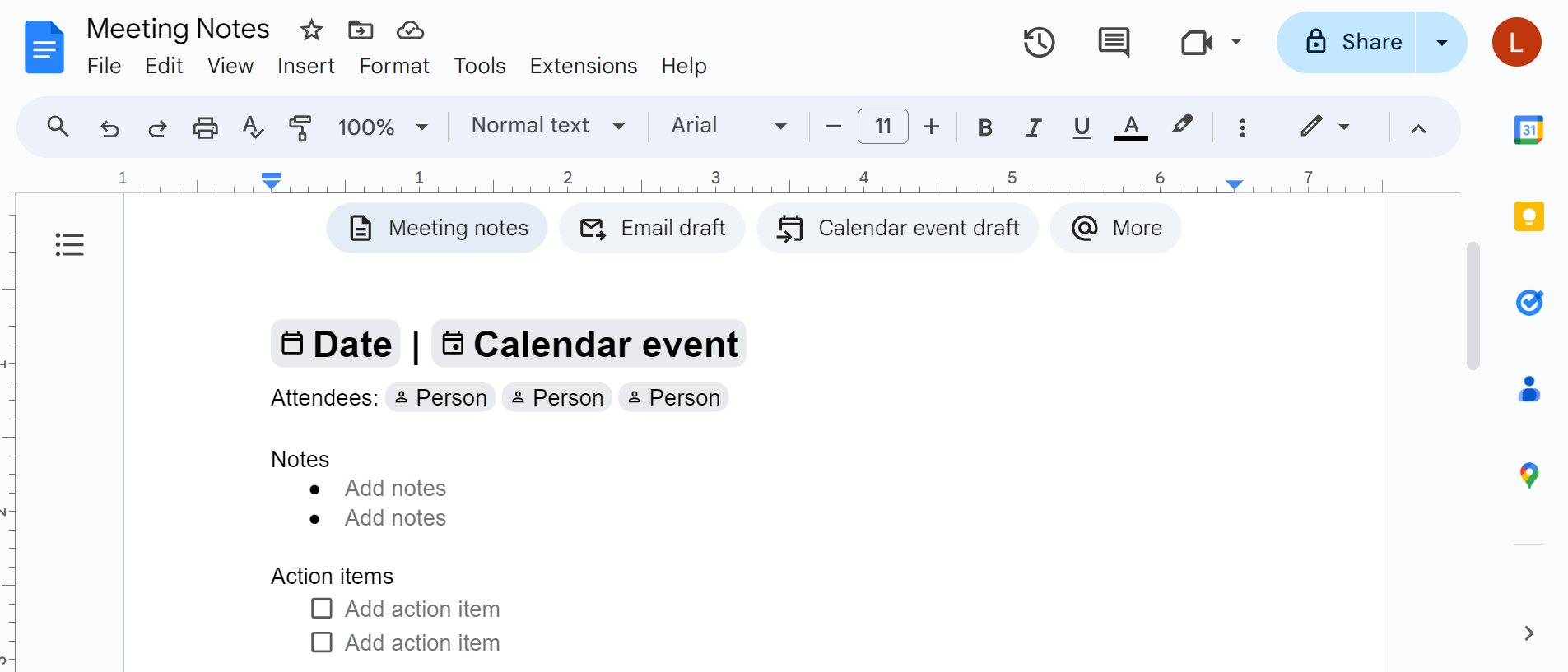“It takes an hour to say six words to complete one small task.”
No one wants to attend meetings that are long, boring, or feel like a waste of time, especially with the number of meetings held on a routine basis. According to Atlassian, the average employee attends 62 meetings a month, and half of those meetings (roughly 31 hours a month) are considered a waste of time.
On the other side of things, no one wants to be known as the person who leads meetings that could have been an email. If the above quote comes to mind, it’s time to rethink your meeting structure.
When conducted effectively, meetings create momentum. They allow people to come together and take an active role in sharing their opinions and ideas to move a project or the business forward.
It turns out there’s an art to leading a meeting. With more than 20 years of working in corporate environments and leading team meetings, I’ve compiled this guide to share how you can lead your meetings to motivate team members and create effective communication on your team.
Related: How to Lead Your Team in the 21st Century
Your Meeting Preparation Checklist
The secret to an effective meeting (like most things in life) is preparation. These are a few essential points to keep in mind for every meeting you lead, whether it’s an in-person meeting, teleconferencing call, or a Zoom meeting organized across five different time zones.
Send items to review in advance
I think most of us can agree that it’s never great to review a 100-slide PowerPoint presentation 5 minutes before a meeting. Make sure to distribute any background materials that team members need to review so they can come to the meeting with well-formed thoughts and questions.
Keep the attendee list short
A meeting can get very expensive when you add up the hourly rate of everyone on your team who joins, especially if you invite an executive leader. According to the Harvard Business Review, $37 billion is lost annually to unproductive meetings. Consider who needs to be present and narrow down the meeting invites. Oftentimes, you don’t need the entire team to join. Jeff Bezos, for example, had the habit of determining meeting attendees based on the Two Pizza rule, where the number of attendees came down to how many people two pizzas would feed.
Keep an eye on the time
Do you start 5-10 minutes late? Do you repeatedly go over the hour? This impacts the effectiveness of your meetings, especially if you have team members joining late and jumping over to other meetings. It’s important to start and end on time. This way you also set the expectation that attendees should plan to arrive on time for future meetings. Sticking to your set meeting time and keeping meetings brief helps make the most of people’s attention spans.
Always have a meeting agenda
A productive meeting comes from having a reason to meet. Whether you have a weekly meeting or monthly catch-up session, you should always have a meeting topic and several agenda items outlined in advance. When building your agenda, it’s helpful to keep in mind the types of meetings you’re leading. Are they meant to be informational, motivational, or related to tackling a special project? Is it meant to be a brainstorming session? That will impact your discussion points and what’s in scope for that meeting.
Leverage technology
Whether you’re leading remote meetings or trying to capture notes, efficient meetings come from tying into technology to help. For example, Zoom’s AI notetaking feature and Otter AI’s meeting transcription can help record meetings for people who might have been out sick that day or need a refresh on what was covered. Plus, when you think about aligning team members (i.e. marketing and sales), recordings can be a major resource to have on hand.
Consider scheduling
If you’re scheduling a strategy meeting, an 8 am meeting might not result in the most caffeinated discussions. Sometimes the time of day can be helpful to consider based on what works best for your team and when they can deliver undivided attention for certain topics. When does your team work best? As a leader, having insights on what makes your team the most effective in their roles is helpful.
How to Effectively Structure Your Meeting
Now, it’s time to lead the meeting. In this case, you can compare successful meetings to your favorite book or movie.
Meetings are about telling a story, requiring three acts that flow together to reach a logical conclusion. The focus is not just to get things done. Ideally, everyone should also walk away feeling confident that the meeting was a good use of their time.
These are the acts that make up the foundation of every effective meeting:
- An introduction
- A meaningful discussion
- An actionable conclusion
With this structure, chances are higher that your colleagues will feel happier knowing their time is not wasted and you’ve set them up for success.
Now, I’ll dive into what each of these three parts involves, including examples of what to say when leading meetings.
Act 1: Kicking Off the Meeting
Also known as setting the scope of the meeting, I encourage teams to start their meetings by thanking everyone for joining and providing a brief outline of their agenda items. An introduction might sound something like this:
[Meeting leader]
“Hi everyone! First of all, thank you all for joining today. As you know, we’ve completed planning as of last month so we’re ready to look at executing our sales strategy. There’s a couple of things on today’s agenda. We need to go over setting up our outreach sequences and make sure we’re all on the same page regarding sales copy and who’s doing what in terms of outreach.”
With this example, I’m making sure that everyone understands that the purpose of the meeting is to discuss outreach sequences, sales copy, and task assignments. This allows the meeting to stay on topic. However, even with a clear agenda, I still have the necessary job of moderating the conversation so we stay on topic for the entire meeting.
Let’s continue to the next act.
Act 2: Creating Meaningful Discussions
I’ve always felt it’s important to “take control” right away during the introduction of a meeting. This means that whoever is leading the meeting is the one doing the talking. The meaningful discussion starts when I invite colleagues to contribute their thoughts, and ideally I want to hear from all team members, not just the loudest voices in the room.
Continuing with our example here:
[Meeting leader]
“Let’s take a look at sequence creation this week. I think we can get away with setting up three targeted email sequences by the end of the week. What’s everyone’s thoughts on that? What do we need to get started on this today?”
By asking these questions, I’m looking specifically at what team members need to get started and any obstacles they’re facing. Any notes taken during this phase will help dictate future action items. Without documenting these answers, meetings tend to end on an unproductive note.
For example:
[Team member]
“I think 3 sequences is definitely possible but I’m worried about the software bugs we’ve been experiencing with the CRM. I’ve heard from someone in Dev Ops that it may take another week before they’re worked out.”
With this team member’s response, there’s a risk the conversation can go out of scope and we may end up talking about system bugs rather than the work in front of us. I encourage meeting leaders to be respectful about raised issues, note them down, and then lead the conversation back to what’s on their agenda.
[Meeting leader]
“That’s a great point. I’ve taken note of this issue and I’ll make sure to follow up with this. Let’s keep our chat focused on building the sequences and I’ll get answers about the bugs.”
Act 3: Ending on a Productive Note
Like any good movie or book, a story without a meaningful conclusion leaves an audience feeling unfulfilled. The same applies to your meetings. During this final act, I always make sure to repeat the main points of the meeting, including the actionable goals that were recorded. This is similar to ‘mirroring’ where you repeat what was said to make sure that the people you’re talking to feel that they’ve been heard.
[Meeting leader]
“Okay, it sounds like we have a pretty good idea of what we need to work on this week. Looking at the notes we will be able to tackle our 3 sequences. We’ve also dialed in our copy to be more compelling.”
Here’s our action items: Jen and Chris will do the write-ups for the sequences. Kathy is updating the brand messaging guidelines, so keep an eye out for her updated brand guide. Does anyone have anything else to add?”
Always be sure to ask if there are additional questions or thoughts. While you’re reassuring everyone they have been heard, there’s always room for questions and comments.
Finally, I’ll close out the meeting, again making sure people know their time and input was valuable.
“Thanks again everyone for meeting today. I think we’ve made some great progress and everyone here is making this possible so thank you. I’ll forward the notes here shortly and our program manager will assign tasks accordingly, so keep an eye out on your inbox.”
What to Do After Your Meeting Ends
Immediately after the meeting ends, I make sure the meeting notes are cleaned up and shared with all meeting participants and key stakeholders. You can do this through a shared document that everyone has access to so they can review the meeting minutes and mark off tasks.
I find that using Google Docs works well, and they have a one-click template for tracking attendees, notes, and action items.

This meeting recap maintains the sense of momentum that was created during the meeting. If notes can’t be shared immediately, make sure they’re sent out within the business day. Acting promptly sets an example for the team and ensures follow-through, which is crucial for success and achieving the business goals you set.
Your meeting creates the foundation for action.
Lead meetings that keep your team on the same page and moving with a powerful sense of momentum. That’s how you lead great teams.
You might also be interested in:
5 Tips to Build a High-Performing Team

